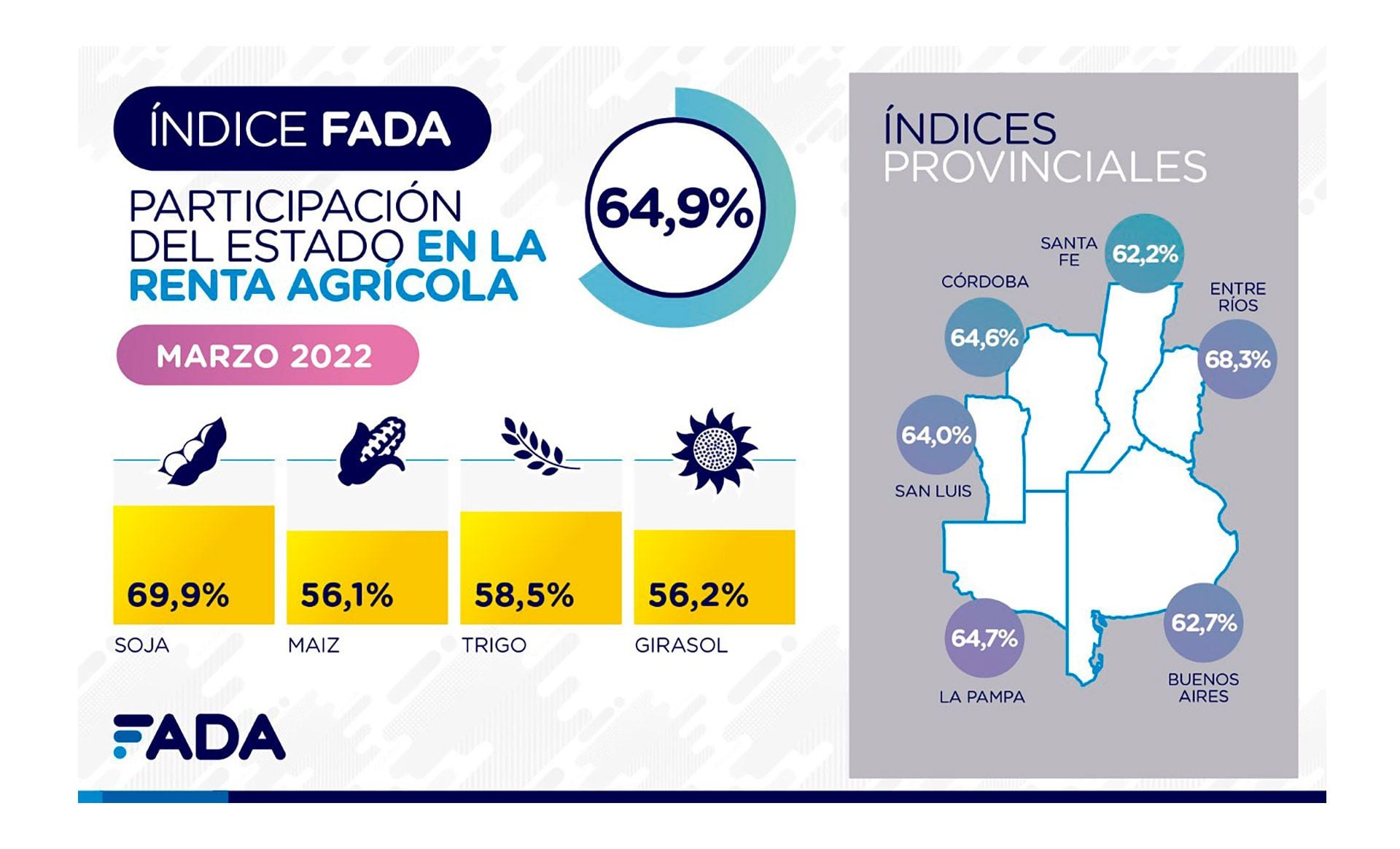
In the midst of a new conflict between the countryside and the Government, which is increasingly gaining strength due to a further increase in tax pressure on the sector through the increase in withholdings of soy by-products, the State's share of agricultural income rose again and is already taking almost 65 pesos out of every 100 pesos that a producer generates from the payment of taxes. This is stated in a new report by the Agricultural Foundation for the Development of Argentina (FADA)
In the first quarter of the year, the State's share of agricultural income at all levels stood at 64.9%, which meant an increase of 1.7 points above that recorded in the last three months of 2021, when taxes represented 63.2% of the total amount generated by a producer. Strictly speaking, this implies that in the first quarter of 2022, the State kept 64.9 pesos out of every 100 pesos that the Argentine farmer produced.
This increase occurs in a context where international and local grain prices are at historically high levels. But the drought impacted our country in such a strong way that those better values could not liquefy the burden of taxes on production. Of course, to this must be added the sharp rise in costs and, in the future, the latest rise in withholdings.
In this regard, FADA economist Nicolle Pisani Claro argued that “even with the significant price increase, the lower yields expected as a result of the drought, higher production costs and the delay of the official dollar compared to inflation were heavier, which is why the index rose in relation to the past index.”
Of all the crops analyzed by the institution, soybeans are the most affected by the removal of the State, mainly because it is the grain that bears the most export duties and also because it was severely affected by drought. Thus, a soybean producer pays 69.9% of income as taxes, while in maize it reaches 56.1%, wheat 58.5% and sunflower 56.2%.

But beyond the proper importance of taxes, international prices and declining prices due to drought, a variable that is increasingly dropping margins in the fields is the steady and abrupt rise in costs, no longer in pesos, but in dollars. “Production costs increased their share. The cost of the harvest, for example, increased by 68.4% in pesos in the last 12 months, while the official exchange rate rose only 19.3%. This means that the cost of the harvest increased by 41.2% in dollars, more than international grain prices rose. Freight rates are even worse, they increased by 47.5% in dollars in the last year,” explained the economist.
Among the costs that rose the most and that most concern producers is that of inputs, especially phytosanitary products and fertilizers. Although in the last 12 months the cost increases of the former have been “extraordinary”, with products rising 50% and 60%, and glyphosates between 140% and 180% in dollars, “the most worrying issue is fertilizers”, as the price of urea increased 170% and PDA 155% in the last 15 months in dollars. But this is compounded by the effects of the war, as both Russia and Ukraine are important producers and exporters of fertilizers. That is why “beyond the price, there is concern about the possible shortage of fertilizers,” stressed the fellow FADA economist, Natalia Ariño.
“Agriculture is very dependent on fertilizer imports. This raises some concern for the sowing of wheat, which begins in a few months, and the sowing of maize that begins in September. While all crops require fertilizers, these are the two that demand the most,” Ariño warns, adding that in 2020, Argentina imported 61% of the domestic supply of nitrogen fertilizers and 79% of phosphates.
Currency arrears and increase in withholding
Another factor that affects the numbers of producers is the exchange rate delay. In this regard, the report indicates that, in the last 12 months, the nominal increase in the official exchange rate was 19.3%, while in terms of the real exchange rate, discounting the effects of inflation, it fell by 21.2% in the last 12 months. “This means that the exchange rate has fallen behind inflation, increasing production costs by measuring them in dollars, a bad scenario for any export activity,” says Ariño.
Thus, the report specified that if the cost structure is analyzed according to the currency in which they are expressed, 54% of the costs of a hectare of soybean are strictly dollarized and if the cost of land is considered it reaches 65%. In the case of corn, since fertilizers and seeds carry more weight than in the case of soybeans, dollarized costs amount to 58%, which reaches 64% with the cost of land.
However, these calculations still lack the impact of the two-point increase in export duties for soybean meal and oil, which went from 31% to 33% to oil and from one percentage point for biodiesel to 30%. Although the Ministry of Agriculture, Livestock and Fisheries, led by Julián Domínguez, assures that this increase will not impact the price received by the producer, FADA believes that farmers will receive a lower price for their soy.
“With the increase in the rate to by-products, the industry will have less purchasing power, so it will be able to pay less for grain. The estimated drop in purchasing power is $15 per tonne. Thus, it is to be expected that, on average, the price paid to the producer will fall around this number”, reveals the economist.
KEEP READING:
Últimas Noticias
Debanhi Escobar: they secured the motel where she was found lifeless in a cistern
Members of the Specialized Prosecutor's Office in Nuevo León secured the Nueva Castilla Motel as part of the investigations into the case

The oldest person in the world died at the age of 119
Kane Tanaka lived in Japan. She was born six months earlier than George Orwell, the same year that the Wright brothers first flew, and Marie Curie became the first woman to win a Nobel Prize

Macabre find in CDMX: they left a body bagged and tied in a taxi
The body was left in the back seats of the car. It was covered with black bags and tied with industrial tape
The eagles of America will face Manchester City in a duel of legends. Here are the details
The top Mexican football champion will play a match with Pep Guardiola's squad in the Lone Star Cup

Why is it good to bring dogs out to know the world when they are puppies
A so-called protection against the spread of diseases threatens the integral development of dogs




